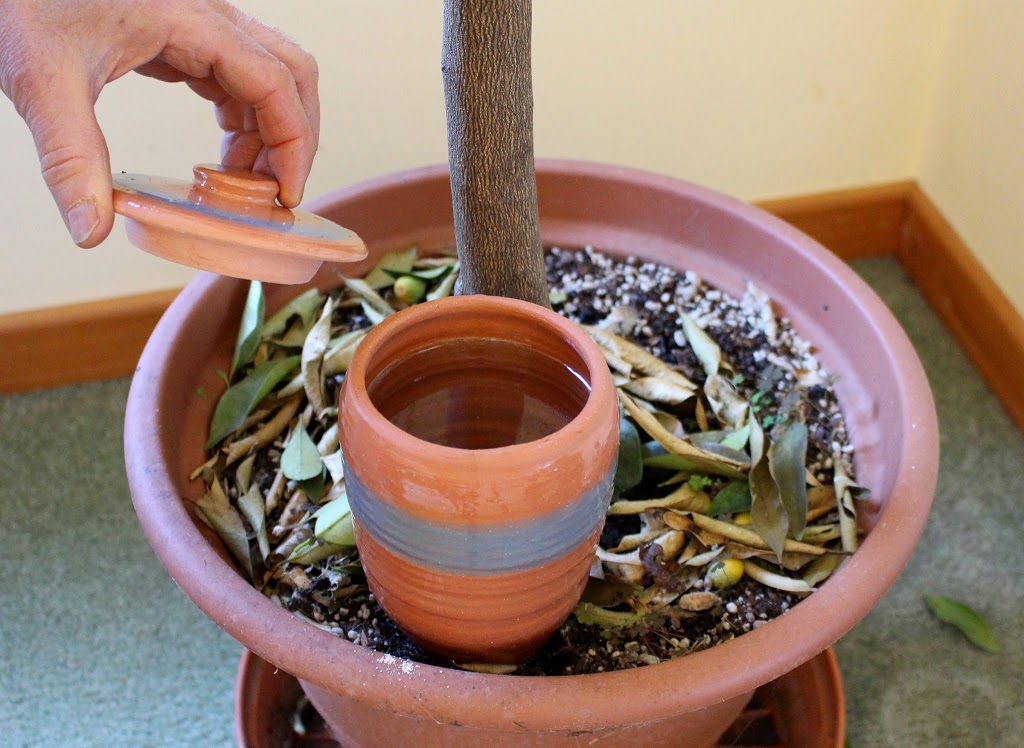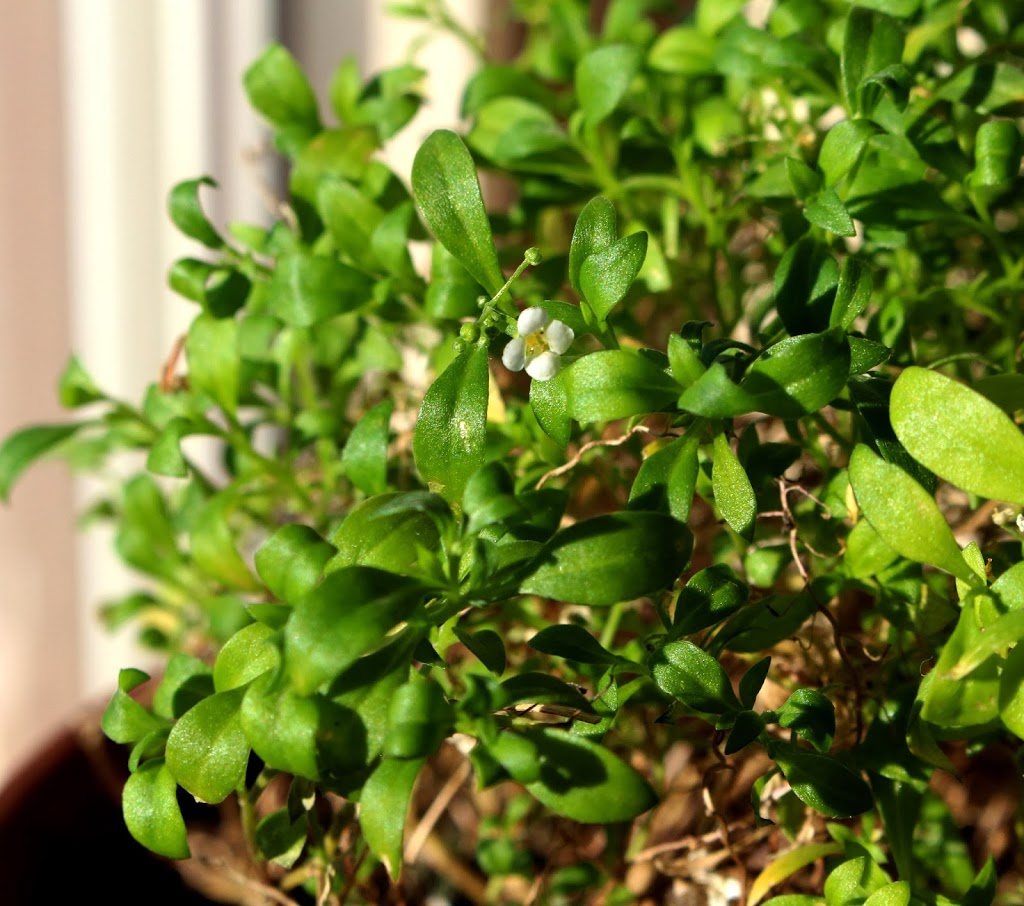Alyssum’s problem may be that it’s too easy to grow. Sprinkle some alyssum seeds on the ground or plug in some transplants, water, and forget about them. Soon you have a mound of tiny, white flowers. That also might be alyssum’s problem. No traffic-stopping colors or humungous or odd-shaped blossoms.
But why think about alyssum (Lobularia maritima) this time of year? Because my alyssum just opened the first of its tiny blossoms. Let’s backtrack, to last spring.
As usual, I was going to sprinkle alyssum seeds on the ground to fill in some areas along the edge of a flower bed where, in all honesty, the plants would probably go unnoticed. Then I realized how much I actually like alyssum if I stop to look at it, and I especially love the blossoms’ honey-like aroma. So instead of
sowing seeds in the ground, I sowed them in a pot. And I placed said pot on the low wall along the walkway leading to my front door. All summer and well into autumn, I’d stop and admire the potted mound of tiny, white blossoms and bend down to drink in their aroma. (Angel’s trumpets, Maid of Orleans jasmine, rose geranium, and mint were among other potted, olfactory delights sharing that low wall.)
Alyssum is a cold hardy annual or short-lived perennial. Winters here are too cold for it to survive outdoors but rather than be sacrificed to winter’s fury, the potted plant found a new home indoors near a sunny window. The plant, native to beaches and fields of the Mediterranean, the Canary Islands, the Azores, and France’s Atlantic coast, tolerates heat, drought, and some shade. Perhaps my indoor plant could be coaxed to flower through winter.
Annual plants expend a lot of energy flowering nonstop through summer. They need periodic rests. My alyssum was pretty much spent by the time I brought it indoors. I should have sheared it back in late August, which would have stimulated and allowed some time for new growth while the growing was good. Because I neglected to do this, not having planned on bringing the plant indoors, it just sat in a state of suspended animation through late fall and early winter.
“Desperate times call for desperate measures.” Okay, the times weren’t particularly desperate, just short days and cool, indoor temperatures. And the measures weren’t that desperate. I sheared back the alyssum about a month ago.
And now came the first of many white blossoms. Unless the plant decides to show its annual-ness and just peter out.
————————————————
 Clay. Plants. Soil. Pots. Depending on perspective, some of these associations are positive; some negative. Clay, soil. Although many gardeners bemoan having such soils, most clay soils are fertile. Clay, plants. The organic spray called ‘Surround’ is nothing more than kaolin clay, which turns out to be a very effective at convincing pestiferous insects to go elsewhere.
Clay. Plants. Soil. Pots. Depending on perspective, some of these associations are positive; some negative. Clay, soil. Although many gardeners bemoan having such soils, most clay soils are fertile. Clay, plants. The organic spray called ‘Surround’ is nothing more than kaolin clay, which turns out to be a very effective at convincing pestiferous insects to go elsewhere.
Clay, pots. Nice. Sculpted and then fired in a kiln turns even the stickiest, most infertile clay into an object of utility and beauty. Lucky for me, my wife Deb is a potter (http://www.goldmanceramics.com), so I occasionally reap marital rewards in the form of pots for plants.
More recently, ceramic marital rewards went further, with the fabrication of an idea I had for an automatic pot watering device, which I’m calling a capillitron. Picture an upside down soda bottle with its bottom end (now up) closed with a removable lid and its top end (now down) tapering to a narrow cone closed off at its end. The whole thing is glazed except for the bottom few inches of tapered cone.
The unglazed portion of the capillatron gets pushed into the soil of a potted plant. The capillatron
reservoir is filled with water, then covered with the lid to prevent evaporation. As the potting soil dries, it draws moisture through the capillary channels of the unglazed, tapered portion of the capillatron, the water in which is continually replaced with the water within the reservoir. The reservoir portion, up out of the soil, is glazed to cut short any capillary migration of water from there to the outside of the pot where it would evaporate.
Within the flower pot, any portion of potting soil that dries will draw moisture from elsewhere in the pot, eventually leading back to right around the capillatron. Theoretically, then, the entire volume of potting soil remains consistently moist as long as the capillatron reservoir holds water. The capillarity within the potting soil, which moves moisture up, down, or sideways, as needed, comes from the organic matter in the mix (compost plus peat moss or coir in mine) and — you guessed it — clay in the garden soil that I add to the potting mix.
 Clay. Plants. Soil. Pots. Depending on perspective, some of these associations are positive; some negative. Clay, soil. Although many gardeners bemoan having such soils, most clay soils are fertile. Clay, plants. The organic spray called ‘Surround’ is nothing more than kaolin clay, which turns out to be a very effective at convincing pestiferous insects to go elsewhere.
Clay. Plants. Soil. Pots. Depending on perspective, some of these associations are positive; some negative. Clay, soil. Although many gardeners bemoan having such soils, most clay soils are fertile. Clay, plants. The organic spray called ‘Surround’ is nothing more than kaolin clay, which turns out to be a very effective at convincing pestiferous insects to go elsewhere.


